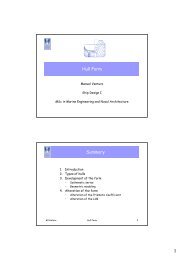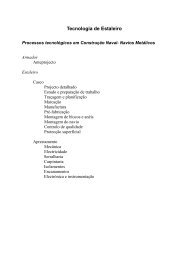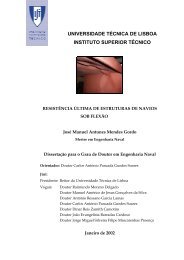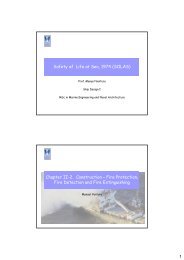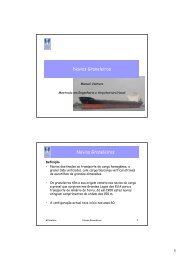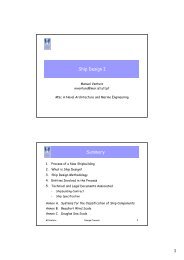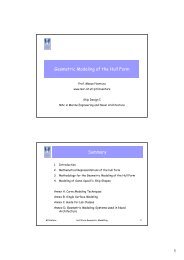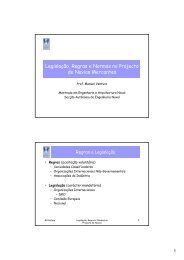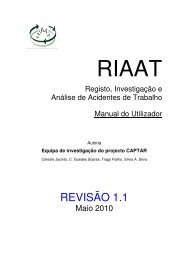COLREGS - International Regulations for Preventing Collisions at Sea
COLREGS - International Regulations for Preventing Collisions at Sea
COLREGS - International Regulations for Preventing Collisions at Sea
You also want an ePaper? Increase the reach of your titles
YUMPU automatically turns print PDFs into web optimized ePapers that Google loves.
file://C:\Documents and Settings\M.Ventura\Local Settings\Temp\~hhA077.htmPage 48 of 742009-09-22the signals prescribed in paragraphs (a) or (b) of this Rule, sound <strong>at</strong> intervals of not more than 2 minutes three blasts insuccession, namely one prolonged followed by two short blasts.(d). A vessel engaged in fishing, when <strong>at</strong> anchor, and a vessel restricted in her ability to manoeuvre when carrying outher work <strong>at</strong> anchor, shall instead of the signals prescribed in paragraph (g) of this Rule sound the signal prescribed inparagraph (c) of this Rule.(e). A vessel towed or if more than one vessel is towed the last vessel of the tow, if manned, shall <strong>at</strong> intervals of notmore than 2 minutes sound four blasts in succession, namely one prolonged followed by three short blasts. Whenpracticable, this signal shall be made immedi<strong>at</strong>ely after the signal made by the towing vessel.(f). When a pushing vessel and a vessel being pushed ahead are rigidly connected in a composite unit they shall beregarded as a power-driven vessel and shall give the signals prescribed in paragraphs (a) or (b) of this Rule.(g). A vessel <strong>at</strong> anchor shall <strong>at</strong> intervals of not more than one minute ring the bell rapidly <strong>for</strong> about 5 seconds. In avessel of 100 metres or more in length the bell shall be sounded in the <strong>for</strong>epart of the vessel and immedi<strong>at</strong>ely after theringing of the bell the gong shall be sounded rapidly <strong>for</strong> about 5 seconds in the after part of the vessel. A vessel <strong>at</strong>anchor may in addition sound three blasts in succession, namely one short, one prolonged and one short blast, to givewarning of her position and of the possibility of collision to an approaching vessel.(h). A vessel aground shall give the bell signal and if required the gong signal prescribed in paragraph (g) of this Ruleand shall, in addition, give three separ<strong>at</strong>e and distinct strokes on the bell immedi<strong>at</strong>ely be<strong>for</strong>e and after the rapid ringingof the bell. A vessel aground may in addition sound an appropri<strong>at</strong>e whistle signal.(i). A vessel of 12 metres or more but less than 20 metres in length shall not be obliged to give the bell signalsprescribed in paragraphs (g) and (h) of this Rule. However, if she does not, she shall make some other efficient soundsignal <strong>at</strong> intervals of not more than 2 minutes.(j). A vessel of less than 12 metres in length shall not be obliged to give the above-mentioned signals but, if she doesnot, shall make some other efficient sound signal <strong>at</strong> intervals of not more than 2 minutes.(k). A pilot vessel when engaged on pilotage duty may in addition to the signals prescribed in paragraphs (a), (b) or (g)of this Rule sound an identity signal consisting of four short blasts.Copyright 2005 Lloyd's Register or <strong>Intern<strong>at</strong>ional</strong> Maritime Organiz<strong>at</strong>ion. All rights reserved. Lloyd's Register, its affili<strong>at</strong>es and subsidiaries and their respectiveofficers, employees or agents are, individually and collectively, referred to in this clause as the 'Lloyd's Register Group'. The Lloyd's Register Group assumes noresponsibility and shall not be liable to any person <strong>for</strong> any loss, damage or expense caused by reliance on the in<strong>for</strong>m<strong>at</strong>ion or advice in this document orhowsoever provided, unless th<strong>at</strong> person has signed a contract with the relevant Lloyd's Register Group entity <strong>for</strong> the provision of this in<strong>for</strong>m<strong>at</strong>ion or advice andin th<strong>at</strong> case any responsibility or liability is exclusively on the terms and conditions set out in th<strong>at</strong> contract.Lloyd’s Register Rulefinder 2005 – Version 9.4<strong>COLREGS</strong> - <strong>Intern<strong>at</strong>ional</strong> <strong>Regul<strong>at</strong>ions</strong> <strong>for</strong> <strong>Preventing</strong> <strong>Collisions</strong> <strong>at</strong> <strong>Sea</strong> - <strong>Intern<strong>at</strong>ional</strong> <strong>Regul<strong>at</strong>ions</strong> <strong>for</strong> preventing<strong>Collisions</strong> <strong>at</strong> <strong>Sea</strong>, 1972 - Rule 36 Signals to <strong>at</strong>tract <strong>at</strong>tentionRule 36Signals to <strong>at</strong>tract <strong>at</strong>tention. If necessary to <strong>at</strong>tract the <strong>at</strong>tention of another vessel any vessel may make light or sound signals th<strong>at</strong> cannot bemistaken <strong>for</strong> any signal authorized elsewhere in these Rules, or may direct the beam of her searchlight in the directionof the danger, in such a way as not to embarrass any vessel. Any light to <strong>at</strong>tract the <strong>at</strong>tention of another vessel shall besuch th<strong>at</strong> it cannot be mistaken <strong>for</strong> any aid to navig<strong>at</strong>ion. For the purpose of this Rule the use of high intensityintermittent or revolving lights, such as strobe lights, shall be avoided.



